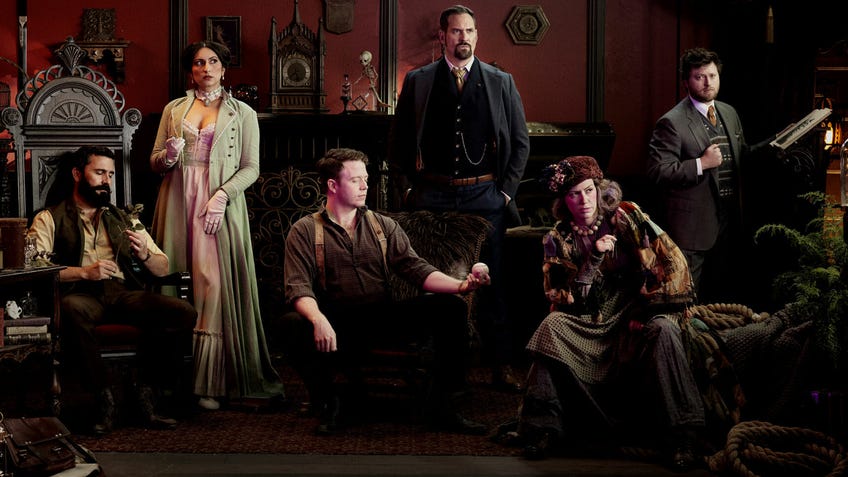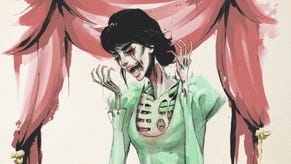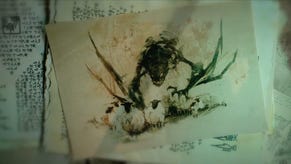The audience at the table is Candela Obscura's biggest strength
Critical Role’s horror anthology has a cineliterate delivery that makes it more like watching a movie - even for those rolling the dice.
It’s a captivating scene in Candela Obscura: Needle & Thread, the second chapter of Critical Role’s horror anthology series. Marion Collodi (Luis Carazo) takes Jean Basar (Zehra Fazal) into a vision of their childhood memories. The magical, otherworldly nature of the space is conveyed by the jewelled purple of the set’s coloured lighting, which then shifts to a green not unlike Jean’s peacoat. It is sensual, and it is intense. As Carazo and Fazal gently steer the scene to its end, game master Spenser Starke narrates for them an intimate serenity. He snaps to fellow players Marisha Ray and Brennan Lee Mulligan and asks for dice rolls they made in the previous scene - ten minutes earlier. Ray and Mulligan are startled at the reminder that they’re still playing this game. Mulligan complains, “I was watching a movie!” Starke teases back, “I'm here enjoying good entertainment.”
Every actual play has two audiences: the one beyond the camera and the one in front of it. It is rare for everyone to be present in every scene, so players will spend at least some of their game time not in the role of a character but as a front-row observer watching from beyond the fourth wall. How present this audience at the table feels to the audience at home depends on each show’s filming and editing decisions. As a live-to-tape production that displays all players simultaneously, as with nearly all of Critical Role’s shows, Candela Obscura starts with a strongly present one. Unless they stand up and leave the table, each player is always visible and their reactions can be seen at all times by the audience at home.
Ray has poked some fun at that fact, joking to ScreenRant that there are two shows: the story and Travis Willingham’s reactions. (Willingham navigates horror with aplomb, but it is well-known that he can be easily startled.) Even with that joke, Candela Obscura is highly aware of this audience at the table and plays toward it as an asset.
Where other productions elide that audience in tighter cameras and a shot-reverse shot editing rhythm, Candela Obscura heightens it with a production design that allows the game master to spotlight one or two actors, leaving the others - or even everyone but the GM - seated in the dark. For the audience at home, who is currently an active player and who is an audience is in literal highlight. For those at the table, watching Starke or another player perform under that lone spotlight isn’t unlike sitting in the audience at a stage performance. Or, in keeping with Mulligan’s breezy complaint, sitting in a movie theatre.

The effect of these spotlights, which have been part of Candela Obscura since chapter one, is intensified by Starke’s cinematic style. He lays out his scenes in the language of film. It’s camera push-ins and point-of-view framing. Starke directs the mind’s eye camera to pan through each character sitting in a carriage, and tells us that we see the group walking down a subway tunnel in a super wide shot. The diction of the film evokes a concept of the audience.
For those at the table, watching Starke or another player perform under that lone spotlight isn’t unlike sitting in the audience at a stage performance.
Starke, speaking to The Mary Sue, found this ability to light individual actors empowering. He highlighted the importance of signalling to players when they are “off” and can simply watch. “That’s so important as a table of storytellers,” he said. “The more invested we can be in each other’s stories, the better ours become.” This investment is crucial for an arc that is so character-driven and navigates an intricate and complicated web of close relationships.
Invested, they are. Willingham buys into the atmosphere so quickly that he flinches at a coat hook during the very first scene of the chapter premiere, roughly 15 minutes before his character is introduced. Ray and Mulligan tease him for it: “Travis, it’s been three minutes.” Ray mouths “kiss,” unseen by Fazal and Carazo, while Jean and Marion flirt. The table is increasingly kicked into an agitated excitement as Starke cuts between Beatrix Monroe (Ray) and Sean Finnerty (Mulligan) in different districts, each time delaying the reveal of which of the two are speaking to a shapeshifting eldritch monster.
This presence of an audience at the table is not unique to Candela Obscura, but this emphasis and deliberate curation around it is rare. It is a boon especially in the horror genre. The clear signalling allows the players to slacken the tension they naturally build up by turning “off” and settling into the safety of being just an audience member, but it can also increase that tension as they realise they are powerless to intervene against events. When it is finally revealed that it is Sean talking to the shapeshifter and Mulligan is asked to make a high-stakes roll, Fazal laments that she cannot do anything to help him. It is the horror of being unable to do anything but watch, the very same always felt by the audience at home.
Through this, the audience at the table becomes a surrogate for us. The clear identification of when these performers are an audience underscores that they feel the same horror and joy and investment in this as we do. We’re all here in the dark enjoying good entertainment, together.





